Have you ever experienced a situation where no matter how hard you try, you cannot get your grass to look as green as you would want? What is even worse is that whenever you look outside the window, your neighbor’s lawn looks like a carpet of bright green grass and is the envy of the entire neighborhood. So, what are you doing wrong? Let’s talk about chelated iron for lawns.
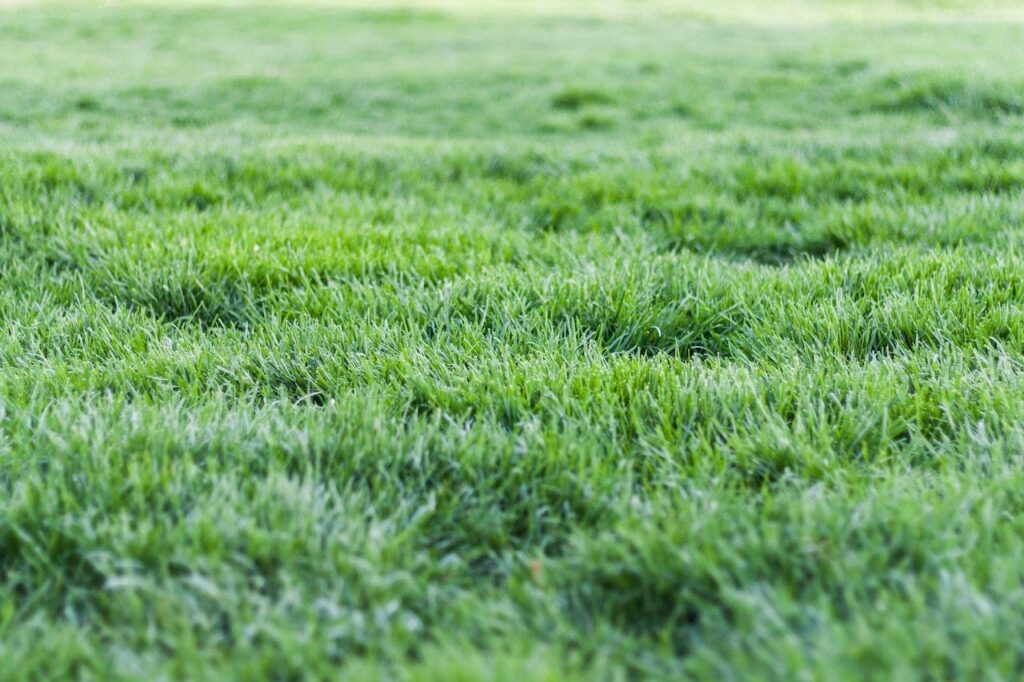
Chelated iron helps the grass develop robust root systems and improves the lawn’s color and quality.
Keeping a yard healthy and green involves regular and careful watering, mowing, aeration, and many other tasks that primarily focus on the well-being of the grass. However, what about the soil? After all, it gives the grass a home to flourish and anchor itself.
Products like chelated iron help replenish the supply of essential elements such as iron in the soil that grass needs to grow and thrive. If your grass is looking pale, in my opinion, chelated iron would be a great product to start with, as it will turn your law green in no time. In addition, chelated iron can also help improve the root system of your grass and make them better at absorbing nutrients from the soil.
So, if you also want to green up your lawn, please read on!
RELATED: The Best Time Of Day To Fertilize Your Lawn | A Comprehensive Guide
But, What Exactly Is Chelated Iron?
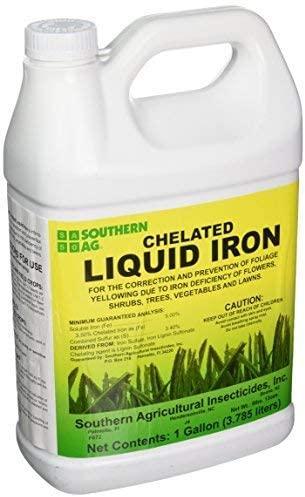
Southern Ag Chelated Liquid Iron – Corrects Iron deficiency in lawns, vegetables, fruits, shrubs & trees.
If you have ever been to a gardening store with shelves full of lawn supplements, you might already be familiar with chelated iron. However, you stayed from it because you did not know what it was, how it worked, and how to use it. Well, don’t worry. We are here to help!
Plants like grass cannot use iron when it is alone or pure as it rusts very quickly when it comes in contact with water and air and isn’t beneficial when applied to a lawn. Furthermore, if you add an excessive quantity of pure iron to the soil, rust will build up in the soil over time, leading to iron toxicity which could weaken or even the grass on your lawn.
Chelated iron is a chemically modified form of iron in which metallic molecules are bonded to non-metallic molecules. The process creates a barrier (layer) over iron and stops it from oxidizing when water and air are exposed. As a result, the grass can continue absorbing the iron as long as it stays in the soil.
Furthermore, the chelating technique keeps the iron from leaching into the soil. That way, iron will remain available for longer to the grass in the ground, and the chance of iron toxicity will also be reduced significantly. All in all, you cannot go wrong with Chelated Iron.
Chelated Iron Types
It is also important to remember that when buying chelated iron products, you will see labels like Fe-EDDHMA, Fe-EDTA, Fe-EDDHA, and Fe-DTPA. Do not hey confused! These are just technical terms for different chelated iron products that are commonly used.
However, there are a few differences! And one of the things in which these chelated iron supplements differ is the pH in which they are most effective.
- EDDHA/EDDHMA > can be used in pH of up to 9.0
- DTPA > can be used in pH of up to 7.0
- HEDTA > can be used in pH of up to 6.0
- EDTA > can be used in pH of up to 6.0
How Does Chelated Iron Works?
If you have ever tried putting a pure iron supplement on your lawn, you would already know that when added, iron starts coagulating in the soil and makes clumps. These clumps create many lawn problems, such as making nutrients in the ground entirely or partially inaccessible to the turfgrass. That’s why iron fertilization is usually dosed in chelated form.
Chelated iron supplements do not have this problem. Iron chelates are trace elements that bind the iron like a claw. It allows them to remain available in solution and thus readily available to the turfgrass when needed. The chelates prevent the precipitation of iron when in contact with water, which also avoids soil clumps.
Chelated iron products also come in various forms, i.e., liquid, granular, and spikes. You can find and read the pros and cons of each in the paragraphs below.
Why Does Lawn Grass Needs Iron?
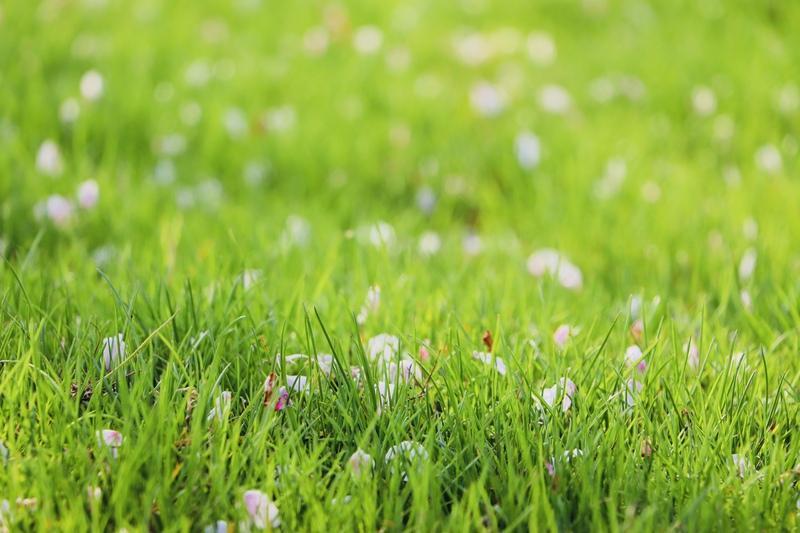
Iron for lawns is needed to support chlorophyll production and reduce moss growth.
Greener grass means a healthier lawn. If your turfgrass looks pale or yellow, the grass is unhealthy. Indeed, water, sunlight, and aeration might help your yard, but in some cases, you need to give your lawn soil a helping hand by boosting its nutrient and iron content.
Iron, including chelated iron, has been long used in yards to promote the health of the grass. Iron is needed by grass for healthy, thick, and lush growth. A lawn without an adequate amount of iron in the soil can start to turn yellow/pale and die off.
Grass Needs Iron To Make Chlorophyll
Plants, including grass, are photosynthetic organisms that need sunlight to make food, grow, thrive, and reproduce. However, to absorb the sunlight, they need chlorophyll which cannot be produced without iron. Furthermore, it is chlorophyll that gives the grass its green color.
So, if your grass lacks iron, it will not have enough chlorophyll, which will not only make it pale but also weak as it won’t be able to absorb enough sunlight.
RELATED: What Is The Best Lawn Fertilizer Ratio? A Comprehensive Guide To N-P-K Numbers
Why Chelated Iron?
While you can use pure iron supplements on your lawn, and people do when they want quick results, these pure iron supplements are often cheap. However, despite their rapid results and low cost, pure iron is not a good choice as it can cause many issues.
To help you understand, let’s go here with an example. If your lawn is losing its lush color and the grass in it is more yellow than green, you may need to spread iron as many times a year to get things going. However, using pure iron supplements every time will cause iron toxicity, and you will end up doing more harm than good to your grass.
Aside from avoiding iron toxicity in the soil when applied as recommended, chelated iron has many other advantages that you might want to consider. For example,
Works Well Will All Soil Types
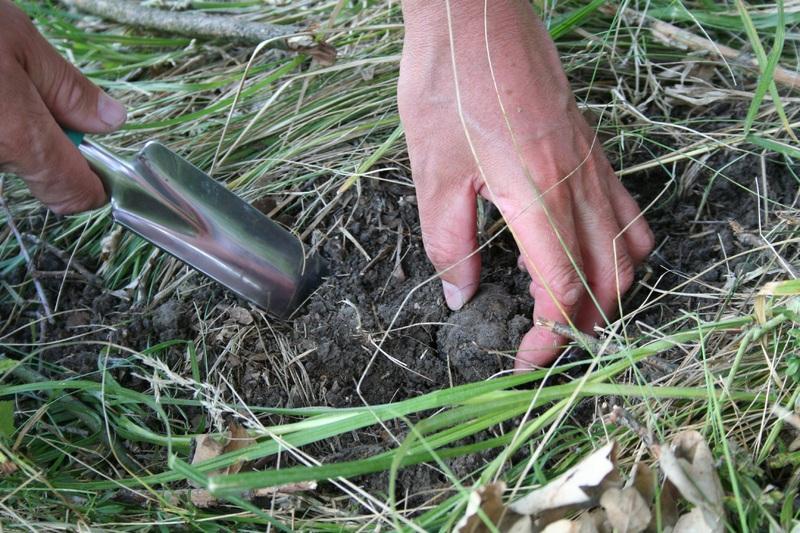
With chelated iron, you do not have to worry about the soil type in your backyard.
More often than not, the deficiency of iron in the soil is caused not by the lack of iron in the ground but by the poor soil quality, which makes it difficult for the grass to absorb iron. It is often a problem in calcareous soils. However, there is not much you can do when your lawn has poor-quality topsoil other than amending it or replacing it all.
And when using an amendment, it must work well with the soil types, a criterion in which chelated iron shines. Chelated iron works flawlessly with almost all soil types and can be used in recommended amounts to amend garden, yard, and lawn soil.
Works At All Times Of The Year
If you have experience taking care of a lawn, you must know that most lawn amendment products need you to apply them to the soil at a specific time of the year for the best or desired results. And there is not much you can do other than wait if the time isn’t right.
However, with chelated iron, you do not have to wait for a specific time of the year to amend your soil. It can be used any time of the year and works all year round. So, you cannot go wrong with chelated iron if you are often on the roads or have a busy schedule.
Chelated Iron Is Versatile
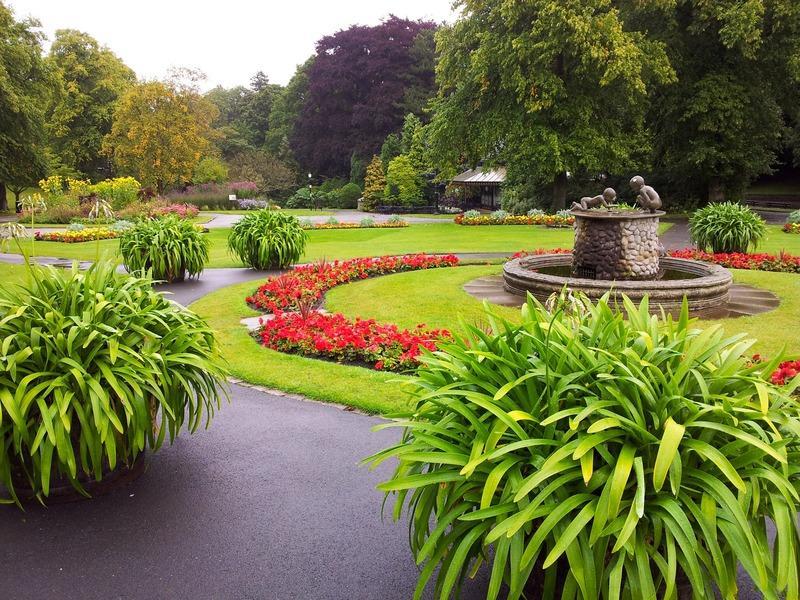
Chelated iron can be used on grass, plants, vegetables, fruits, flower beds, and ornamental trees.
All plants need iron, whether flowers, fruits, ornamental trees, or grass. However, most plant products nowadays are often labeled to be only used by certain types of plants, which limits their use and, in the long run, needs you to spend more money on plant care.
However, if you buy chelated iron, you can use it anywhere in your home for plants, be it your flower bed, lawn, or vegetable garden. Sprinkle some, and you are good to go.
The iron supplement will not only make them look great but also make them healthier.
It Is Available Both As Synthetic & Organic
Chelated iron products are available in synthetic and organic forms, and you can buy anyone depending on your preferences and requirements. For example, if you have an outdoor party, guests are coming over, and you need a quick makeover of your lawn, a synthetic chelated iron product will green up your lawn grass in no time.
However, if you are not in much haste, I highly recommend buying an organic chelated iron product for your lawn. These products not only boost the iron content of your yard but also have many other nutrients that grass needs for healthy growth.
In addition, organic products have much fewer side effects than synthetic products. For example, they will not stain concrete if accidentally spilled around the lawn.
Types Of Chelated Iron For Lawns
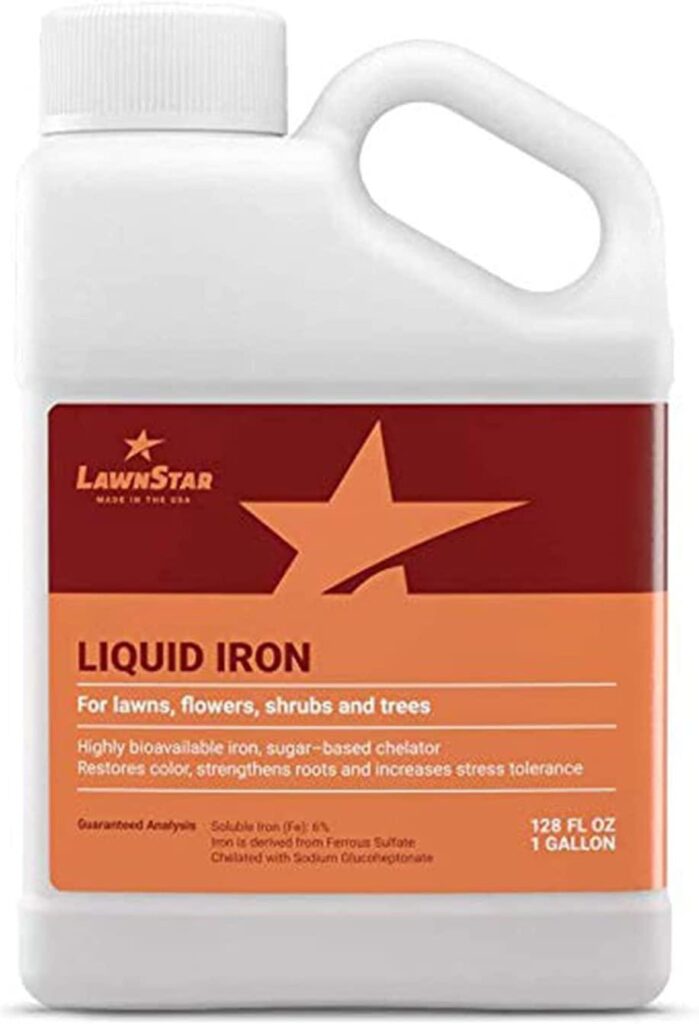
Chelated iron is available in all liquid, granular, powdered, and spike/needles forms.
Like many lawn soil amendment products, chelated iron is also available in liquid, granular, spikes, or powdered form. You can choose any depending on your preferences, needs, and what you aim to do with your lawn. In my experience, liquid products work the fastest and are available in ready-to-spray and liquid concentrate forms.
However, powdered or granular forms might also come in handy from time to time, depending on the situation. Nevertheless, each of these products has its pros, cons, and best-use scenarios, which are described below in brief detail:
Chelated Iron Spikes
If you are looking for a slow-release and long-lasting chelated iron product, I suggest you consider chelated iron spikes. These spikes are very slightly soluble in the water, and their large size offers the soil sufficient nutrients even when applied in small amounts.
It makes them a cost-effective and time-saving option. However, you will need to water them into the soil for the product to activate. But if there is a rain prediction, spread them on your lawn before, and that way, you would not even need to water them later.
You can buy chelated iron spikes mixed with other essential trace minerals such as potassium, manganese, and magnesium, or you can purchase needles with chelated iron alone. However, ensure you choose a product that works with your soil’s pH.
Chelated Iron Pellets/Granules
As good as chelated iron spikes are, they can be challenging to work with or sometimes produce much slower results than you want to obtain. That is where chelated iron granules or pellets can help. These chelated iron products work quickly and dissolve relatively soon in the soil. However, like spikes, you only need to spread them first in the ground.
Furthermore, when compared to liquid products, dry forms are easier to store. All you have to do is spread them in recommended quantities and then water the soil to get them into the ground. And, if you get it done before it rains, you will have to work even less.
Liquid Chelated Iron
As already described, if you want the fastest possible results, you should use a liquid chelated iron product. There are many available on the market, and I will discuss a few at the end of this article to help you make the most out of your money.
They work their way into the soil immediately, where they get absorbed by the grassroots, and you may even see yellow grass turning green in just a few days. Some liquid-chelated iron products are also combined with fungicides and herbicides. However, before choosing such products, ensure you know what you are looking for.
Furthermore, liquid-chelated iron products can be purchased in ready-to-use spray or liquid concentrate. I suggest you buy a ready-to-use spray form if you want absolute comfort and do not have much time to calculate and mix the product correctly.
RELATED: How To Identify and Treat Common Fungal Diseases Of The Lawn | A Comprehensive Guide
How Long Does Chelated Iron Take To Work?
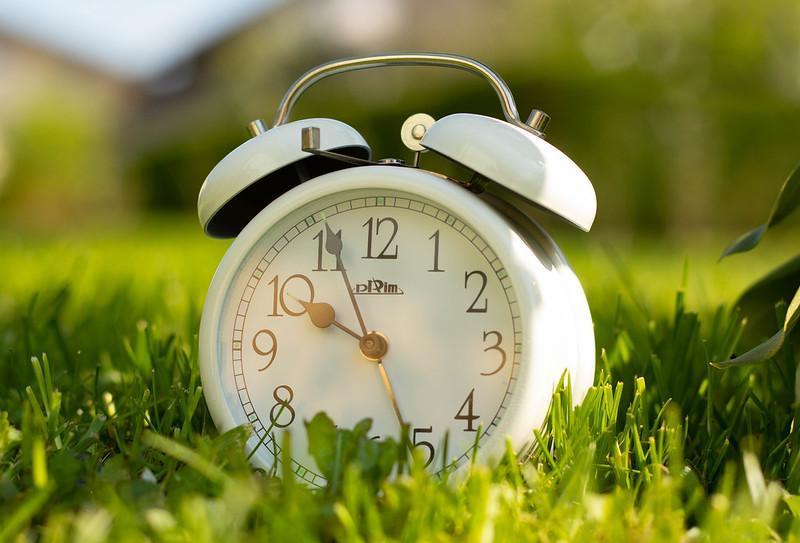
Liquid iron takes around four days to 3 weeks to work on a lawn and produce results.
How long your chelated iron product will take to work depends on three main things.
First is the type of product you use; as already stated, liquid products work the quickest. Secondly, the extent of iron deficiency in your soil, and thirdly, and most importantly, the pH of your soil. Therefore, you must test your soil to see its pH level and choose a chelated iron product that works best for your lawn soil. Choosing the right product will significantly reduce the time between the product application and snd seeing results.
Usually, it takes about four days to three weeks for the chelated iron to work its magic in your yard once you have selected and applied the right product. During this time, chelated iron reacts with the soil pH and makes iron available to the grass.
Following that, of course, your lawn grass needs to benefit from it and process it into chlorophyll, ultimately giving the grass its lush, bright, and green color.
How To Use Chelated Liquid Iron?

When spraying chelating iron, wear protective clothing, as chelated liquid iron can cause skin irritation.
Let’s discuss applying liquid chelated iron products to your lawn, as applying granular, and spike forms are pretty straightforward. Most people have no problem using them for their properties. However, applying liquid products can be trickier as there is a greater likelihood of applying too much and spilling the product, which can cause stains.
First, let’s discuss the concentrated liquid chelated iron. These products need to be mixed with water before use. Usually, most products come with instructions, and you must combine two or three tablespoons in a bucket of water. But some may require more water.
In contrast, ready-to-use sprays need only to be attached to your hose, and you can spray them as you run across your lawn. However, please ensure you spread it evenly and wear protective gear, as chelated iron can produce skin burn/irritation on contact.
How Often Should You Apply Chelated Iron?
How often you apply chelated iron on your lawn depends on the soil test results. It will not only guide you about the iron content/concentration of your soil but also tell you how many applications of a particular product you need to amend your soil.
And, no doubt, you will need to follow the product label instructions when applying chelated iron to your lawn. Typically, most products recommend waiting thirty days between each application. But here are some good guidelines you can follow:
- If your lawn is more yellow than green, you might need as many as seven to ten applications per growing season to make your yard look better.
- However, if your lawn is more green than yellow, you might be able to get the job done by as few as three to four applications per growing season.
When To Apply Chelated Iron To Lawns?

The general rule is to use iron supplements on your lawn in the spring for the best results.
While you can apply a chelated iron product to your lawn at any time of the year, I highly recommend that you keep the below instructions in mind and use the product at the right time to make the most out of it. So, let’s get started.
Most experts agree that you should apply iron to your lawn in spring for the best results. Iron delivers the best results when the soil temperature is between 40 and 80 degrees Fahrenheit and the air temperature is between the 60s and 80s.
As always, see the product label for instructions on how and when to apply the iron for the best results. And, please, in no case, apply iron to your lawn when it is too hot outside. Using iron in heat can cause your grass to burn and turn your grass yellow/brown.
Also, please do not apply iron on cold or freezing days when the temperature is too low.
Can Chelated Iron Hurt Your Lawn?
Chelated iron works best when applied at the right time and in the right amount, as with any other lawn amendment product. If you use too much, you may do more harm than good. However, many brands might claim their product will not damage the grass if overused. Trust me, that is total bullshit, and please do not fall for these claims!
If you apply too much iron to your lawn, you might quickly see grass greening up and become healthy. However, in the long run, too much iron in the soil will start damaging the grassroots, which will cause the death of the grassroots and the lawn.
Therefore, please stick with the recommended amounts and not overuse the product.
Best Chelated Iron Products For Lawns
Finally, let’s see what some of the best iron (chelated) products available on the market are and their pros and cons. So, let’s get going and help you pick.
LawnStar Chelated Liquid Iron

LawnStar Chelated Liquid Iron (32 OZ) for Plants – Multi-Purpose.
| Pros | Cons |
| It is EDTA-free. It is pet and people-friendly. It can produce results in just a few days. | It is somewhat pricey. It can stain concrete if spilled. |
Sometimes, your grass cannot get to the iron in the soil because it has a high or alkaline pH. In such situations, you should give this product a try. It lowers the soil pH and makes the iron in the soil available to the grass. Moreover, it also has nitrogen, another mineral that grass needs to grow, spread and maintain its lush green color.
Consumers are also delighted with its results. Some have even said they saw results in as few as five days. Nevertheless, wear protective clothing when applying it and add the concentrate to water following the label directions.
Commercial Grade Lawn Energizer
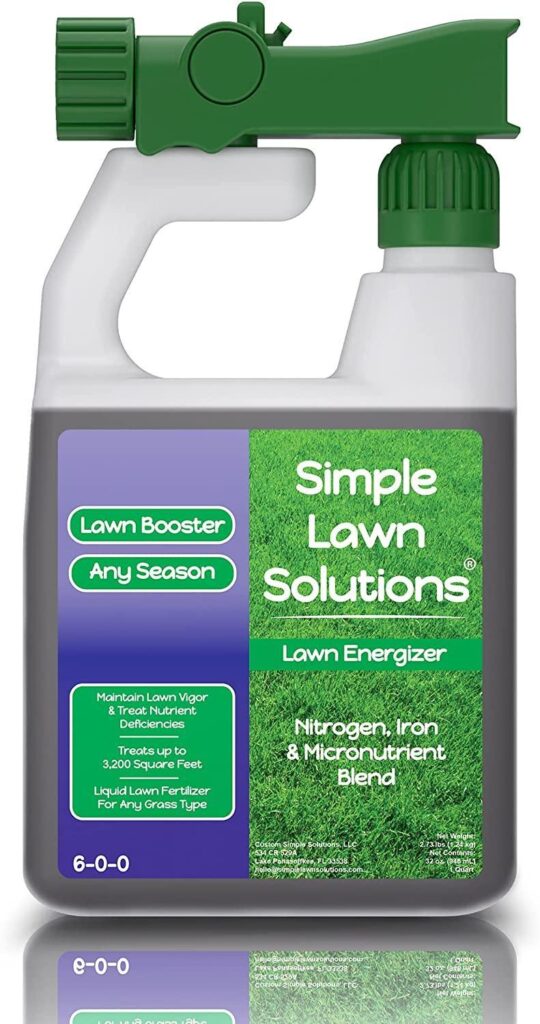
Liquid Turf Spray Concentrated Fertilizer – Grass Micronutrient Booster with Iron & Nitrogen.
| Pros | Cons |
| It has added zinc, magnesium, and manganese. It also enriches and fertilizes the soil. | It does not balance the pH of the ground. |
If the soil test result shows that your lawn soil lacks iron and other essential lawn minerals, I highly recommend choosing this product. It not only adds iron to your lawn soil but also revitalizes it by introducing critical minerals.
Furthermore, the product comes in the read-to-spray form; you do not have to mix it with water. To begin, attach it to your garden spray hose and shoot away. Users have left many great reviews about this product, and I confirm these reviews too.
The only back draw of this product is that it does not adjust the pH of the soil.
Southern Ag Chelated Liquid Iron

Southern Ag Chelated Liquid Iron – Corrects Iron deficiency in lawns, vegetables, fruits, shrubs & trees.
| Pros | Cons |
| It also has sulfur in it, an essential mineral. It remains stable even in highly alkaline soil. | It is not compatible with other lawn products. It can heavily stain skin and hard surfaces. |
If you have a big lawn, this product is for you. You only need to add a tablespoon of it to one gallon of water, and you have prepared an iron concoction to treat your lawn. However, do not apply this mixture during sunny times as it can burn the grass.
The product contains about 5% iron combined with sulfur to lower the pH of the soil. And what is even better is that it remains stable in the ground at a pH of 9 or higher. Nevertheless, once you have applied the product to the soil, the results will appear in a few days.
The only back draw of this product is that it can leave heavy stains on skin and concrete.
Final Thoughts
Chelated iron products can provide a quick and easy fix if you have iron-deficient soil. However, the iron you add will eventually be lost, and you might again end up with an iron deficiency in the soil, and your grass and lawn will start to turn yellow.
The permanent solution is to get to the root cause of the problem and fix it. Typically, heavily irrigated soils and high pH are to blame for the iron deficiency of a lawn. So, get your soil tested, and please ensure that you only water your lawn when needed.
Frequently Asked Questions (FAQs)
Is liquid iron for lawns safe for pets?
Liquid iron products that contain EDTA are toxic for pets and people. So, if you have used an EDTA-containing chelated iron product on your lawn, please keep your pets and children away from the grass as long as the property is not completely dry.
Can chelated iron stain paths or concrete?
Chelated iron products, especially liquid ones, can cause heavy stains on paths, concreates, and skin. So, please ensure that you use these products with care, do not spill, and cover yourself with the proper protective gear when applying them on your lawn.
Is chelated iron good for grass?
Chelated iron provides grass with iron, and the grass needs iron to produce chlorophyll. And if you do not know already, chlorophyll is the molecule that gives the grass its green color. However, do not overuse it, as it can quickly burn and discolor the grass.
How long do you need to leave liquid iron on the grass?
Most liquid iron products available on the market suggest leaving them for at least one hour on the grass to allow them to dry. Also, some of these products have EDTA, which is toxic. So, please keep your pets and children away until the grass is dry.
How do I know if my lawn needs iron?
The first sign of an iron deficiency is usually a light green on top of your grass blades. It may occur in swatches across the lawn, just like a nitrogen deficiency. So, if you notice that your yard has patches of yellow and is relatively thin, then the grass needs iron.
Sources For Further Reading
Understanding and Applying Chelated Fertilizers Effectively Based on Soil pH. (2023). Retrieved 7 February 2023, from https://edis.ifas.ufl.edu/publication/HS1208
Iron-based Herbicides | The University of Maryland Extension. (2023). Retrieved 7 February 2023, from https://extension.umd.edu/resource/iron-based-herbicides
University, U. (2023). Preventing and Treating Iron Chlorosis in Trees and Shrubs | Forestry | Extension. Retrieved 7 February 2023, from https://extension.usu.edu/forestry/trees-cities-towns/tree-care/preventing-iron-chlorosis
Thank you for reading this article about chelated iron for lawns. Also, check out our other articles:
How To Get Bermuda Grass To Spread Fast | Bermuda Grass Lawn Care Tips
How Often Should I Fertilize My Lawn? A Quick & Easy Guide To Lawn Fertilization
The Best Organic Fertilizers For Home Lawns For A Greener & Healthier Yard







